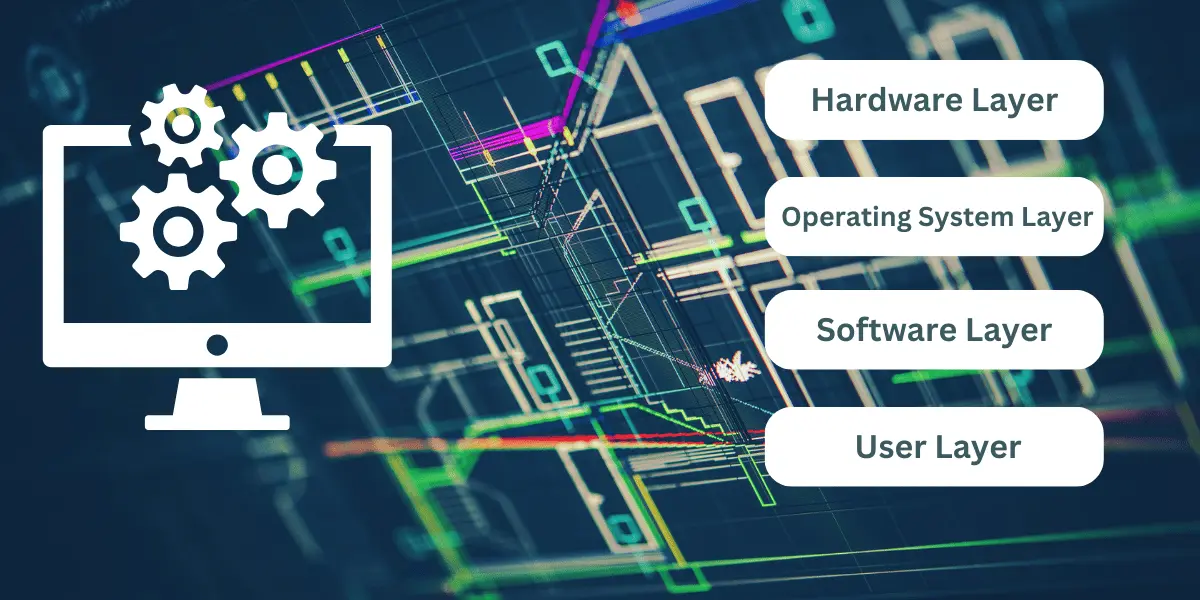Computer architecture is one of the most essential ideas in computing. It describes how different parts are designed and built and how they connect to do computations. Knowing the four main parts of computer architecture (hardware, operating system, software, and user help), you understand how computers work and how to make them work best for different tasks.
1.The Hardware Layer
What are the four main parts of a computer’s structure? It is built on top of the hardware layer. The main parts of a computer system are:
Central Processing Unit:
The CPU is the computer’s brain. It runs software commands and controls how data moves through the system.
Random Access Memory (RAM):
RAM stores data and instructions that the CPU needs to quickly quickly.
Storage Devices:
Hard and solid-state drives keep data and software safe.
People can connect to the computer through input/output devices when using keyboards, mice, and monitors, among other things.
To Understand the hardware layer is essential for improving system efficiency, upgrading parts, and fixing hardware related problems.
2.The Operating System Layer
The Operating System is the second part of a computer’s design. This layer connects (hardware and software, manages resources, and makes the interface easy to use).
Resource Management:
The operating system controls CPU time, memory usage, and disk space to ensure that programs run smoothly.
File System:
This part of the computer groups and controls the files on your storage devices. Users and programs can read, write to, and delete files.
The operating system gives users a graphical interface to connect with the system and organize files.
Windows and Android are popular operating systems. Each one has different security features, performance levels, and features to meet the wants of other users.
3.Software Layer
The software layer is the third part of a computer’s design. It comprises all the programs and apps that run on the operating system. Almost all software people use daily, from web browsers and word processors to games and specialized software, works on this layer.
Application Software:
These are programs made to do specific things, like Adobe Photoshop for changing photos or Microsoft Word for working with words.
System Software:
It includes antivirus software, disk management software, and drivers that let hardware talk to the OS. These are the services and tools that help keep the system running.
You need to know about the software layer to choose the right apps for your needs, improve software speed, and ensure that it works with your operating system.
4.The User Layer
The User Layer is the last layer of a computer’s design. This layer comprises the people who use the computer system. Users can be anyone from casual web surfers to experts running complicated simulations.
Interaction With the User:
Input devices let users enter directions and data processed by the layers below.
Personalization:
To improve their computing experience, users can make their surroundings more like them by installing software, changing settings, and customizing the user interface.
Security:
Users must keep their systems safe by using strong passwords and keeping their software updated.
The user layer is the most flexible because it depends on the person’s tastes and skill level.
How the Four Layers Interact?
To understand computer design, you must know how these four layers work together. Each level depends on the one below it:
- Hardware helps the Operating System run by giving it the physical tools it needs.
- The Operating System manages resources and provides services that the Software needs to work.
- Software gives the user tools and programs that they can use to do different things.
- The computer system works smoothly and safely thanks to this structured relationship.
FAQ’s
Q1: Why is Understanding the Four Main Layers of Computer Architecture Important?
By understanding these layers, users can make their systems run better, fix problems, and make intelligent choices about updates and software.
Q2: How does the Operating System Handle Hardware Resources?
The operating system ensures that all apps can run without problems by ensuring that they have enough CPU time and storage space.
Q3: Can Users Directly Interact with the Hardware Layer?
It is rare for users to connect directly with the hardware layer. Instead, the operating system and software talk to the hardware on their behalf.
Q4: How can I Improve my Computer’s Performance Across These Layers?
Getting rid of old technology, updating the operating system, and using correct software can all improve performance. An occasional disk clean-up and virus scan can also keep the system running efficiently.
Conclusion
To sum up, anyone wanting to learn more about computers needs to know the four main layers of computer architecture. Every part is vital to how it works, from the hardware to the person using the computer.
Users can make better decisions about their systems, improve speed, and solve problems more quickly and easily if they understand how these layers work together.
Noah Oliver is a seasoned tech writer with four years of experience, unraveling complex topics into clear, engaging content. With a passion for all things technology, Noah crafts insightful articles that empower readers to stay ahead in the fast-evolving digital world.

